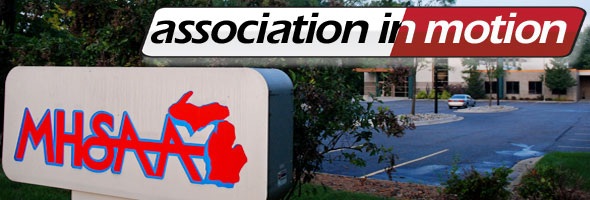
Pay-to-Play Down Slightly, Survey Shows
July 24, 2018
By Geoff Kimmerly
Second Half editor
Slightly less than 50 percent of MHSAA member high schools assessed sports participation fees during the 2017-18 school year, according to an annual survey that enjoyed its highest response rate in 14 years of measuring the prevalence of charging students to help fund interscholastic athletics.
This year’s survey was completed by a record 80 percent of the MHSAA’s 751 member high schools, and 49 percent of respondents charged participation fees – down slightly from 49.7 percent in 2016-17, when the rate dropped below 50 percent for the first time since 2009-10.
The MHSAA conducted its first participation fee survey during the 2003-04 school year, when 24 percent of responding schools reported they charged fees. The percentage of member schools charging fees crossed 50 percent in 2010-11 and reached a high of 56.6 percent in 2013-14.
Class A schools remained the largest group charging fees in 2017-18, with 65 percent of respondents doing so – although that percentage was the lowest for Class A since 66 percent reported using fees in 2011-12. Class B schools fell to 47 percent charging fees (from 52 percent in 2016-17), while Class C (46 percent) and Class D (37) schools remained below 50 percent as well.
Charging a standardized fee for each team on which a student-athlete participates – regardless of the number of teams – remains the most popular method among schools assessing fees, with that rate at 43 percent of schools. Schools charging a one-time standardized fee per student-athlete showed a slight decrease to 28 percent, while assessing fees based on tiers of the number of sports a student-athlete plays (for example, charging a larger fee for the first team and less for additional sports) and assessing fees based on the specific sport being played (some being more expensive than others) both showed slight upticks to 15 and 5 percent, respectively.
The amounts of most fees remained consistent during 2017-18: the median annual maximum fee per student at $150, the median annual maximum family fee at $300 and the median per-team fee at $75 – all for at least the fourth straight year. The median fee assessed by schools that charge student-athletes once per year held steady at $125 for the second straight school year.
Click for the survey for 2017-18, and surveys from previous years can be found here.

MHSAA Reveals Football Playoff Format
September 25, 2020
By Geoff Kimmerly
Second Half editor
The Representative Council of the Michigan High School Athletic Association has approved an adjusted format for this season’s 11 and 8-Player Football Playoffs to accommodate the shortened regular season that began late due to COVID-19-related restrictions earlier this fall.
All teams this season are able to play up to six regular-season games before the start of the MHSAA Playoffs – down from the usual nine games because the first games this season weren’t played until the traditional Week 4. However, the playoff fields for both 11 and 8-player will be doubled this season, giving nearly every team in Michigan a guaranteed seventh game.
Changes to the football postseason are for the 2020 season only. Following are brief descriptions of the adjusted MHSAA Football Playoffs in each format:
11-PLAYER
· Field: 512 teams. (There are currently 507 playing 11-player football this season, so five teams are scheduled to receive first-round byes at this time.)
· Schedule: 3 District Rounds, Regional Finals, Semifinals, Finals. The host sites for the Semifinals and Finals will be pre-arranged and announced at a later time. Finals will be played the weekend of Dec. 4-6.
· Brackets: Teams have been placed in pre-arranged divisions based on enrollment. Teams in Districts will be seeded 1-8 based on playoff-point average, with the teams with highest averages hosting at the District and Regional levels. Because of a small number of teams opting to not play this fall, division lines were adjusted from what was released during the spring classification announcement, moving 20 teams to different divisions than previously published – those changes will be reflected next week on the playoff points page of the MHSAA Website. Click for District groupings.
8-PLAYER
· Field: 64 teams. (There are currently 78 teams playing 8-player this season. Those teams that finish the season but do not qualify for the playoffs will be allowed to schedule one more game against other non-qualifiers.)
· Schedule: 3 Regional Rounds, Semifinals, Finals. Finals will be played the weekend of Nov. 27-28 at site(s) to be determined.
· Brackets: Teams were placed in pre-arranged divisions based on enrollment during the classification process this spring. The top 32 teams in each division based on playoff-point average will qualify for the playoffs. Brackets will be drawn and announced Oct. 25. Teams with higher playoff-point averages will host Regional and Semifinal games. Additionally, there are six 8-player teams too large by enrollment to qualify for the playoffs; they will be allowed to schedule their own non-MHSAA playoff if they choose to do so after the regular season.
Further details will be provided soon on the Football page of the MHSAA Website.
The Representative Council is the 19-member legislative body of the MHSAA. All but five are elected by member schools. Four members are appointed by the Council to facilitate representation of females and minorities, and the 19th position is occupied by the Superintendent of Public Instruction or designee.
The MHSAA is a private, not-for-profit corporation of voluntary membership by more than 1,500 public and private senior high schools and junior high/middle schools which exists to develop common rules for athletic eligibility and competition. No government funds or tax dollars support the MHSAA, which was the first such association nationally to not accept membership dues or tournament entry fees from schools. Member schools which enforce these rules are permitted to participate in MHSAA tournaments, which attract more than 1.4 million spectators each year.

